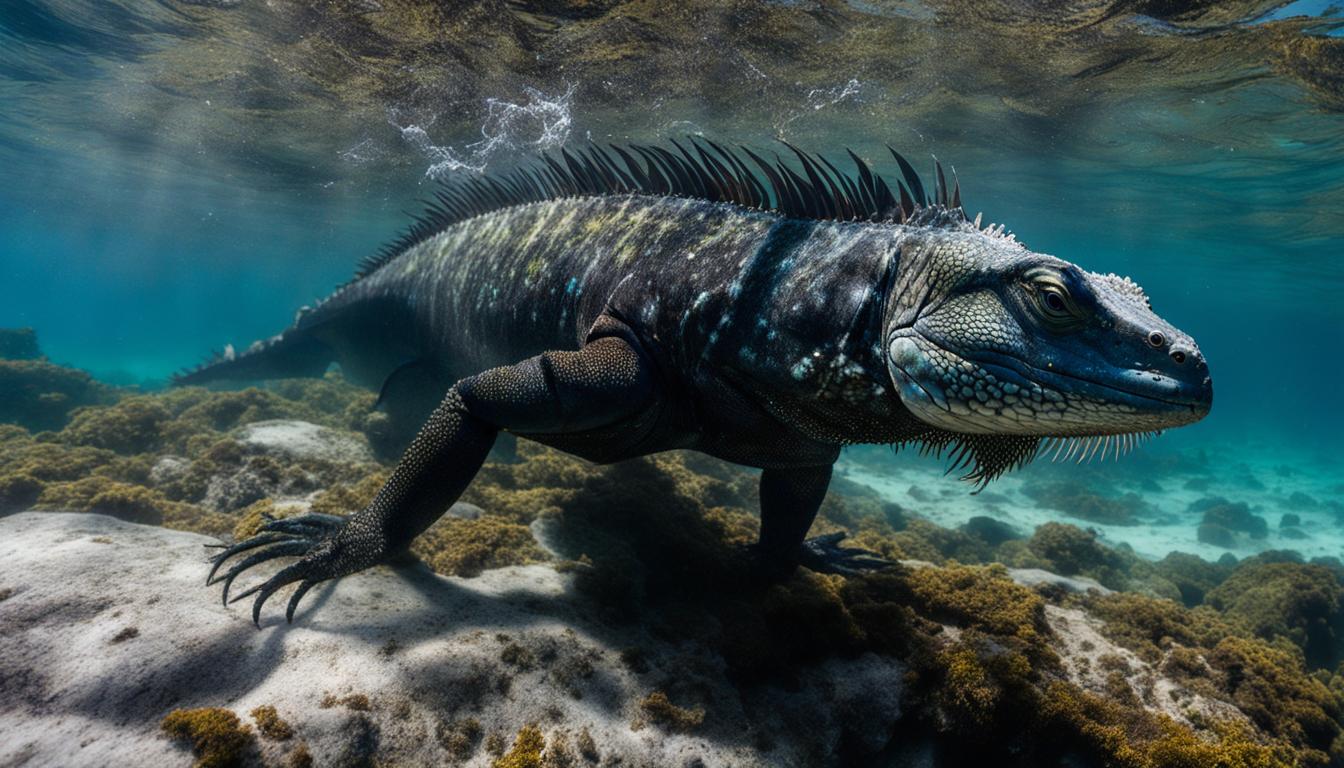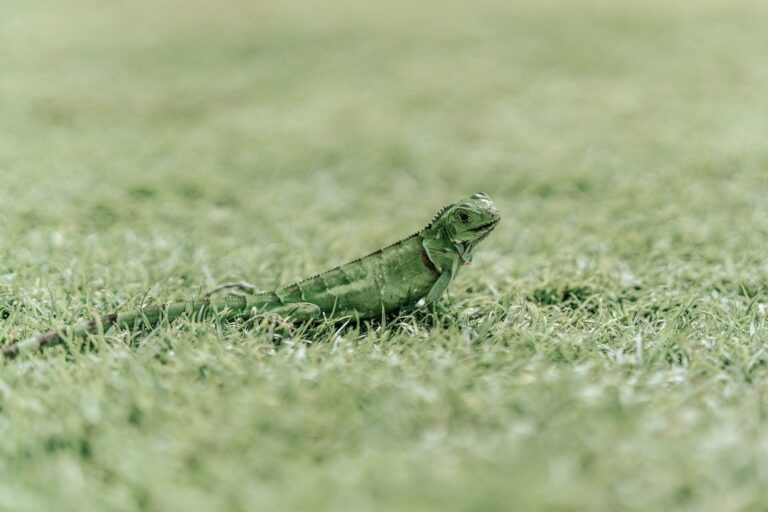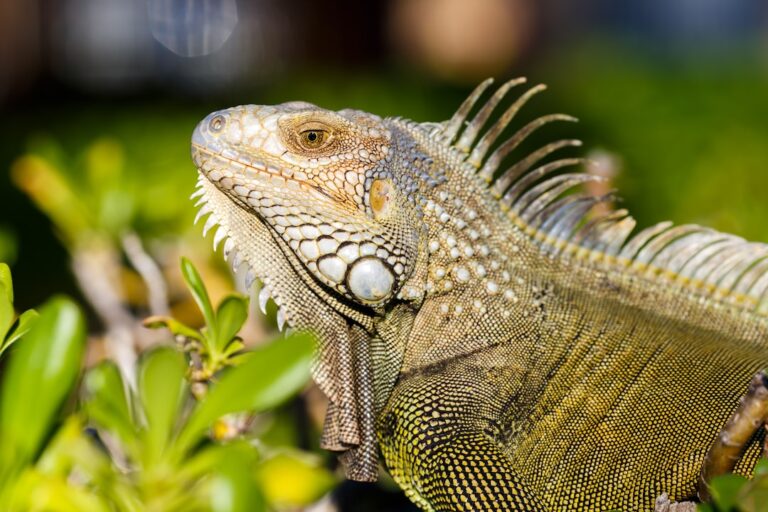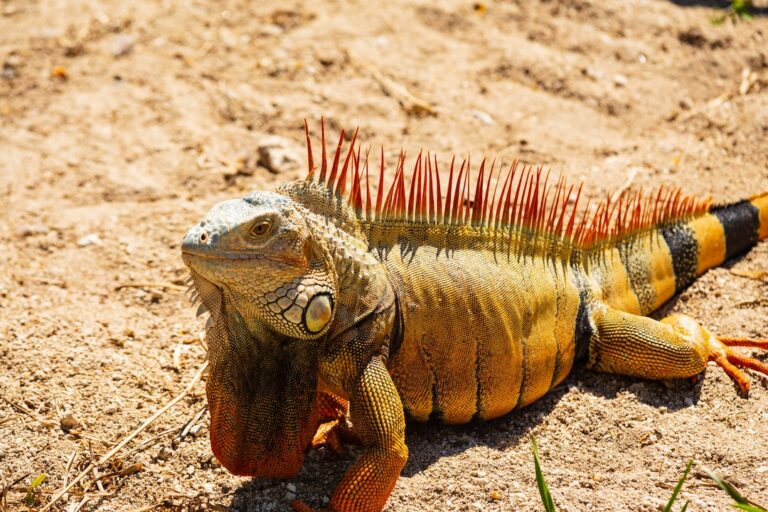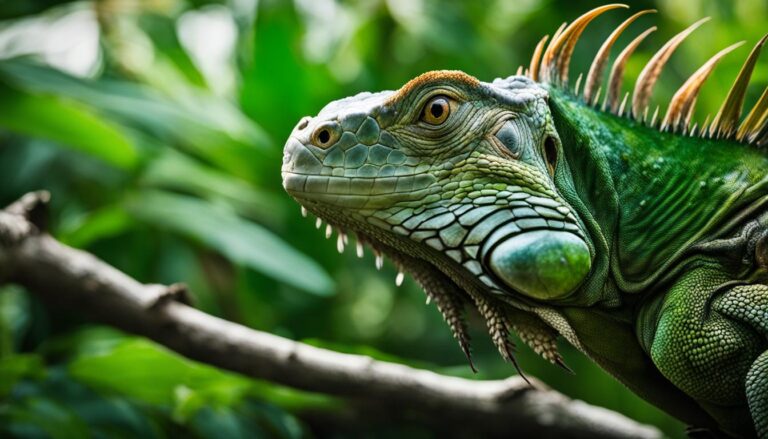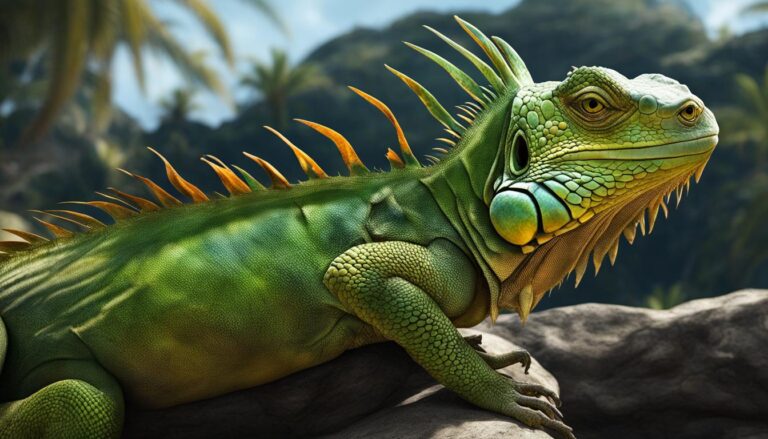Can Iguanas Breathe Underwater?
Welcome to our exploration of the fascinating world of iguanas and their remarkable abilities in aquatic environments. When you think of an iguana, you might envision a lizard basking in the sun or climbing on tree branches. But did you know that some iguanas are actually skilled underwater breathers? In this article, we will dive into the depths to uncover the secrets of the marine iguana and its extraordinary adaptations.
When it comes to iguanas, the marine iguana is the ultimate amphibious creature. Found exclusively in the Galapagos Islands, these remarkable reptiles have perfected the art of underwater survival. From their unique physiology to their specialized behaviors, marine iguanas are a true testament to the wonders of nature.
So, can iguanas breathe underwater? Let’s unravel this mystery together!
Table of Contents
Key Takeaways:
- Some iguanas, such as the marine iguana, have adapted to thrive in aquatic environments.
- Marine iguanas possess unique physiological adaptations that enable them to breathe underwater.
- These reptiles have specialized behaviors and physical characteristics that aid their survival in marine habitats.
- The Galapagos Islands are home to the remarkable marine iguanas, the only seafaring lizards in the world.
- Understanding the breathing abilities of iguanas is crucial for their conservation and the preservation of their habitats.
Understanding Iguana Physiology
To fully comprehend the remarkable ability of iguanas to thrive in various environments, it is crucial to delve into their fascinating physiology. Iguanas, including both land and aquatic species, exhibit distinct physiological characteristics that enable them to adapt and survive in their respective habitats.
The Difference Between Land and Aquatic Iguanas
Land iguanas primarily inhabit dry terrestrial habitats, while aquatic iguanas, such as the renowned marine iguanas of the Galapagos Islands, have adapted to life in marine environments. While both types belong to the iguana family, they possess notable physiological differences that allow them to navigate their distinct habitats with ease.
Land iguanas have a sturdy body structure with powerful limbs, enabling them to traverse rocky terrains and climb trees. These iguanas have well-developed limbs for efficient movement on land and foraging for vegetation.
Aquatic iguanas, on the other hand, have a streamlined body shape, which facilitates their movement through water. Their flattened tails and long, slender bodies allow them to navigate their marine habitats with agility, making them exceptional swimmers.
Specialized Adaptations for Marine Habitats
Marine iguanas showcase an array of unique adaptations that enable them to thrive in marine habitats, where no other lizards can survive. One remarkable adaptation is their ability to forage for food underwater. Marine iguanas possess specialized jaws and sharp teeth that help them scrape algae from rocks in their marine environments, their primary food source.
Another notable adaptation is the ability of marine iguanas to regulate their body temperature. To warm up after foraging in cool waters, these iguanas bask on rocky shores, absorbing heat from the sun. Furthermore, their dark coloration allows them to efficiently absorb and retain heat, promoting thermoregulation.
The marine iguanas possess unique salt glands located near their nostrils, which they use to excrete excess salt absorbed during their marine expeditions. This adaptation allows them to maintain proper sodium levels and excrete excess salt, ensuring their survival in the harsh marine environment.
| Characteristics | Land Iguanas | Aquatic Iguanas |
|---|---|---|
| Body Structure | Sturdy, powerful limbs | Streamlined body, flattened tail |
| Primary Habitat | Dry terrestrial habitats | Marine environments |
| Feeding Adaptations | Foraging for vegetation | Scraping algae from rocks |
| Thermoregulation | N/A | Basking to absorb heat |
| Salt Excretion | N/A | Utilizing specialized salt glands |
Unveiling the Mystery: Can Iguanas Breathe Underwater?
One of the intriguing aspects of iguanas is their ability to adapt to aquatic environments. It raises the question: can iguanas breathe underwater? To unravel this mystery, we must delve into the fascinating respiratory system of these remarkable creatures.
Iguanas possess a unique respiratory system that enables them to extract oxygen while submerged. Unlike humans, who rely on lungs to breathe, iguanas have developed a specialized mechanism to facilitate underwater breathing. They employ a combination of both pulmonary and cutaneous respiration, allowing them to absorb a sufficient amount of oxygen from the surrounding water.
When underwater, iguanas rely primarily on their lungs, which function similarly to terrestrial reptiles. They can hold their breath for extended periods, conserving oxygen and adapting to the low-oxygen environment. However, to further enhance their oxygen intake, iguanas also utilize their skin for respiration.
An amazing adaptation within the iguana respiratory system is their highly vascularized skin. The skin of iguanas is rich in blood vessels, which aid in the absorption of oxygen from the water. This unique ability to extract oxygen through the skin enables iguanas to supplement their lung respiration and enhance their underwater endurance.
Iguanas also possess a modified nasal cavity that plays a crucial role in their underwater breathing. Their nostrils are equipped with a valve-like structure that allows them to seal their nasal passages, preventing water from entering. This adaptation ensures that they can inhale air without the risk of water entering their respiratory system.
Observing an iguana in its underwater habitat is truly awe-inspiring. As they gracefully navigate through the depths, these remarkable creatures effortlessly demonstrate their ability to breathe underwater. The mystery of how iguanas breathe beneath the surface has been unveiled, revealing the intricate adaptations that enable them to survive and thrive in aquatic environments.
Distinctive Features of the Marine Iguana
The marine iguana, native to the Galapagos Islands, possesses several unique features that enable it to thrive in its aquatic environment. These distinctive characteristics include adaptive coloration for heat absorption and the presence of salt glands, which facilitate a unique excretion mechanism.
Adaptive Coloration for Heat Absorption
The marine iguana exhibits remarkable adaptive coloration that plays a crucial role in heat absorption. Its dark gray or black body coloration allows it to effectively absorb solar radiation, warming its cold-blooded body. This adaptation helps the iguana regulate its body temperature in the cool marine environment, enabling it to comfortably forage for food underwater.
Salt Glands: A Unique Mechanism
One of the most remarkable features of the marine iguana is its unique salt glands. These specialized glands located near their nasal passages allow the iguanas to excrete excess salt from their bodies. As marine iguanas often consume seaweed, which is high in salt content, these glands are crucial for maintaining their electrolyte balance. The ability to excrete excess salt through these glands is essential for their survival in an environment where freshwater sources are scarce.
How Marine Iguanas Manage Oxygen While Underwater
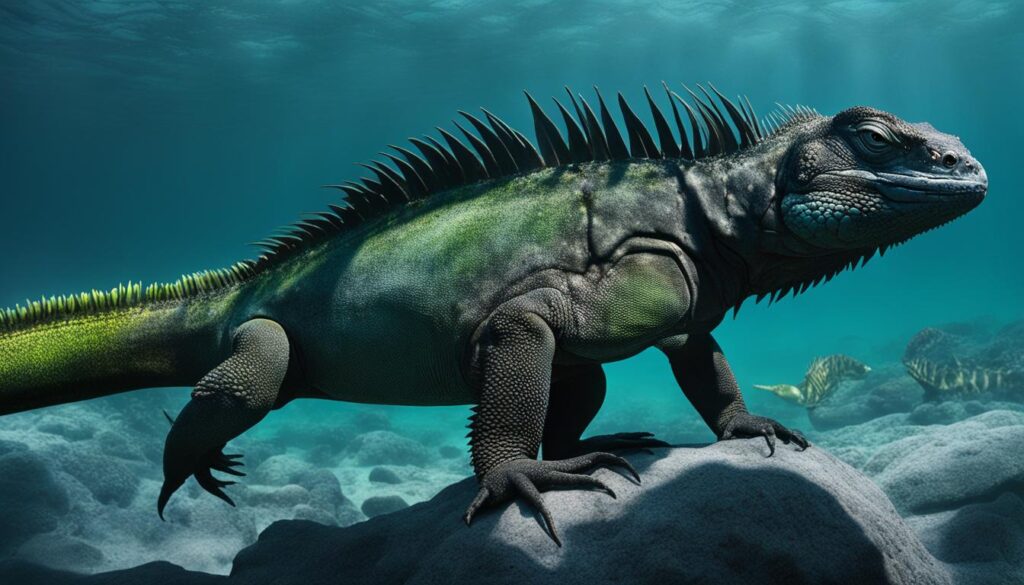
Marine iguanas have developed unique adaptations that allow them to efficiently manage oxygen while submerged. These adaptations enable them to engage in prolonged dives and enhance their breath-holding capacity. However, they also face certain limitations in terms of dive times.
Adaptations for Prolonged Dives
Marine iguanas have several physiological adaptations that assist them in undertaking prolonged dives. One such adaptation is their ability to slow down their metabolic rate while underwater. By doing so, they conserve energy and reduce the need for oxygen intake, allowing them to stay submerged for longer periods.
Another notable adaptation is their specialized respiratory system. Marine iguanas possess a unique arrangement of blood vessels in their lungs that allows for efficient gas exchange. This adaptation enables them to extract a higher concentration of oxygen from each breath, maximizing their utilization of available oxygen during dives.
Additionally, marine iguanas have larger lungs relative to their body size, which provides them with increased oxygen storage capacity. This allows them to take in more oxygen during each breath and prolong their time underwater.
Limitations of Iguana Dive Times
While marine iguanas have impressive adaptations for prolonged dives, they still face certain limitations in terms of their dive times. One significant limitation is their reliance on surface breathing. After a dive, marine iguanas need to return to the surface to breathe and replenish their oxygen levels. This reliance on frequent surface breathing restricts the duration of their dives.
Another constraint is their breath-holding capacity. Despite their adaptations, marine iguanas have a limited ability to hold their breath compared to some other marine animals. Their breath-holding capacity is influenced by factors such as their age, size, and overall health status.
It’s crucial for marine iguanas to carefully manage their oxygen intake and exertion during dives to optimize their dive times and ensure their survival in their challenging aquatic habitat.
The Feeding Habits of Marine Iguanas
Marine iguanas have unique feeding habits that are closely linked to their diving behavior and physiological adaptations. Understanding their diet and the correlation with diving depth provides valuable insights into their survival strategies in marine environments. Additionally, the intake of algae plays a significant role in their breath-holding capacity, allowing them to stay submerged for extended periods.
Understanding Diet and Diving Depth Correlation
The diet of marine iguanas primarily consists of marine algae, specifically the green algae that grows along rocky coastlines and underwater surfaces. These reptiles have evolved to consume algae, which is abundant in their coastal habitats. Interestingly, their diving depth is directly related to the availability of algae. In areas where easier access to algae is limited, marine iguanas have been observed diving to greater depths in search of their main food source. This correlation highlights their remarkable ability to adapt and thrive in challenging marine ecosystems.
How Algae Intake Influences Breath-Holding Capacity
The consumption of algae by marine iguanas has a significant impact on their breath-holding capacity. Algae are rich in nutrients, including oxygen. When iguanas consume algae, they not only fulfill their nutritional needs but also intake oxygen stored within the algae. This oxygen contributes to their ability to hold their breath for extended periods while diving. The more algae they consume, the greater their oxygen intake, enabling them to sustain longer dives and increase their chances of locating food.
| Diet | Diving Depth | Algae Intake | Breath-Holding Capacity |
|---|---|---|---|
| Primarily marine algae | Correlated with algae availability | Significant intake as a food source | Influences ability to hold breath during dives |
Behavioral Patterns Related to Iguanas and Water
Iguanas exhibit fascinating behavioral patterns when it comes to their interaction with water. While these reptiles are not natural swimmers like amphibians or marine mammals, they can navigate through water surprisingly well.
When swimming, iguanas use their long tails to propel themselves forward, while their powerful limbs help them maintain balance and maneuver. They can gracefully glide through the water, using their strong legs to paddle and steer, making swimming appear almost effortless.
However, iguanas are primarily terrestrial animals, and their swimming abilities are not comparable to those of truly aquatic species. They are more suited to short bursts of swimming and are typically found in water bodies such as rivers, streams, and lagoons.
In addition to swimming, iguanas also exhibit other interesting behaviors related to water. One such behavior is basking. Iguanas often seek out sunny spots near water sources, where they can sunbathe and regulate their body temperature. Basking allows them to absorb the warmth of the sun, which is essential for their physiological well-being.
Another behavior displayed by iguanas near water is sunbathing. They often stretch themselves out on rocks, logs, or sandy shores, exposing their bodies to direct sunlight. Sunbathing helps iguanas dry off after swimming and aids in thermoregulation, ensuring their body temperature remains within the optimal range.
These behavioral patterns related to water play a crucial role in the iguana’s life. From swimming to basking and sunbathing, each behavior serves a specific purpose in their survival and overall well-being.
Environmental Challenges Facing Marine Iguanas
Marine iguanas, like many other wildlife species, face significant environmental challenges in their habitats. One of the key concerns is climate change and its impact on their feeding behaviors. As temperatures rise and weather patterns become more unpredictable, marine iguanas must navigate changing food availability and adapt their strategies to survive.
Climate Change and Its Impact on Feeding Behaviors
Climate change has profound effects on the marine environment, directly affecting the availability and distribution of food sources for marine iguanas. Rising sea temperatures and changing ocean currents disrupt the delicate balance of marine ecosystems, leading to shifts in algae populations, which represent the primary food source for these unique lizards.
As warming oceans alter the composition and productivity of marine habitats, marine iguanas must adjust their feeding behaviors to locate and obtain sufficient sustenance. These adaptations are crucial for their survival and the maintenance of their populations.
Adaptive Strategies During Food Shortages
Marine iguanas have developed remarkable adaptive strategies to cope with periods of food shortages. When faced with limited algae resources, they employ various behavioral and physiological mechanisms to conserve energy and maximize their chances of survival.
During food shortages, marine iguanas exhibit reduced activity levels to conserve energy. They may also opportunistically switch to alternative food sources, such as consuming invertebrates or other marine organisms that are available during these challenging times.
Furthermore, marine iguanas have been observed to undergo plastic changes in their feeding behaviors, altering their diving depths and foraging strategies based on the abundance and availability of algae. This flexibility allows them to exploit areas where food is more plentiful, optimizing their chances of obtaining sufficient sustenance.
| Environmental Challenge | Impact on Marine Iguanas |
|---|---|
| Climate Change | Disrupts food availability and necessitates adaptive feeding behaviors |
| Food Shortages | Triggers behavioral and physiological adaptations to cope with limited resources |
The Role of Salt Glands in Marine Iguana Survival
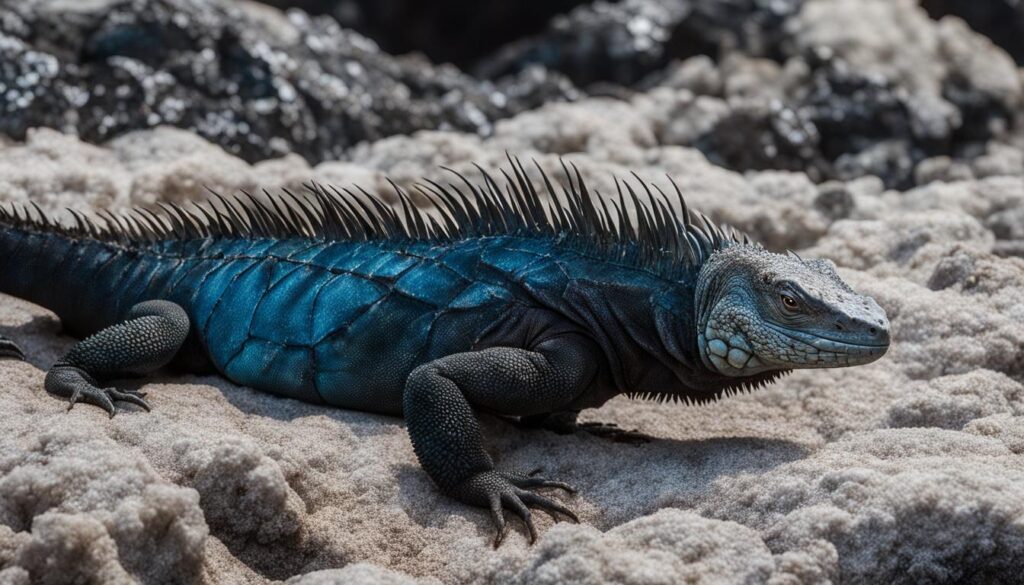
The survival of marine iguanas in their aquatic habitats relies on a variety of remarkable adaptations. One of the key physiological adaptations that enables their survival is the presence of salt glands. These specialized glands play a crucial role in maintaining the osmotic balance and overall well-being of these fascinating creatures.
Function and Importance of Nasal Salt Glands
The nasal salt glands, located in the heads of marine iguanas, are responsible for regulating the excretion of excess salt from their bodies. As these iguanas consume seaweed and algae, their bodies naturally accumulate high levels of salt. The nasal salt glands act as a filtration system, allowing these reptiles to eliminate the excess salt from their bloodstream.
By secreting concentrated saltwater through their nostrils, marine iguanas effectively remove excess salt, preventing it from building up in their bodies and causing dehydration. This process is essential for their survival in marine environments, where freshwater is scarce and high levels of salt are present.
The efficient functioning of the nasal salt glands is crucial for the overall health and well-being of marine iguanas. Without these glands, the salt accumulation in their bodies would become toxic, leading to dehydration, impaired organ function, and ultimately, death.
Aquatic Adaptations: More Than Skin Deep
While the function of nasal salt glands is a critical adaptation for survival in marine environments, marine iguanas have also developed a range of other physiological adaptations. These adaptations allow them to thrive in aquatic habitats and cope with the challenges they face.
One notable adaptation is the ability to swim and dive underwater in search of food. The streamlined bodies, muscular tails, and long claws of marine iguanas aid in their swimming abilities, allowing them to navigate their marine habitats efficiently. Their reduced body fat and dense, sodium-absorbing bones further enhance their ability to dive and forage for extended periods of time.
Additionally, marine iguanas have developed a unique metabolic system that enables them to withstand long periods without food. During times of food scarcity, their metabolism slows down, allowing them to conserve energy and survive until a new food source becomes available. This adaptation exemplifies their remarkable ability to adapt to the demanding conditions of their environment.
| Physiological Adaptation | Function |
|---|---|
| Nasal Salt Glands | Regulate salt excretion and prevent dehydration |
| Streamlined Bodies and Muscular Tails | Aid in swimming abilities |
| Reduced Body Fat and Dense Bones | Enhance diving capabilities |
| Slow Metabolism | Allows survival during food scarcity |
These physiological adaptations collectively contribute to the remarkable ability of marine iguanas to thrive in aquatic environments. Their unique features and mechanisms ensure their survival in challenging conditions and provide invaluable insights into the resilience and adaptability of the natural world.
Reproduction and Life Cycle of Marine Iguanas
The reproduction and life cycle of marine iguanas are fascinating processes that contribute to the survival and population growth of these unique creatures. From the intriguing mating process to the challenges faced by hatchlings as they mature, every stage holds significant importance.
The Intriguing Mating Process
The mating process of marine iguanas is a captivating display of courtship and competition. During the breeding season, male iguanas engage in territorial battles to establish their dominance. The victorious male attracts females through elaborate displays, including head bobs and color changes, demonstrating their fitness for reproduction.
Once a male captures the attention of a female, they engage in a ritualistic dance, intertwining their bodies. This reproductive act is vital for the fertilization of eggs and ensures the continuation of the species.
From Hatching to Maturity: Overcoming Predators
After the successful mating process, female marine iguanas lay their eggs in sandy nests on the shores of their nesting sites. These nests are vulnerable to predators such as birds, crabs, and snakes. However, the female iguanas cover the nests with layers of sand to provide camouflage and protection.
Upon hatching, the young iguanas face numerous challenges on their journey to maturity. They must navigate their way to the ocean, avoiding predators lurking on the shore. Once in the water, they become vulnerable to aquatic predators, such as sharks and large fish.
Survival depends on their ability to evade these threats and find refuge in the rocky intertidal zones. Here, they can feed on algae and develop the necessary strength to withstand the harsh marine environment.
At this stage, the juvenile iguanas grow rapidly, shedding their skin several times to accommodate their increasing size. This growth is crucial for reaching sexual maturity, which typically occurs between 3 to 5 years of age.
As they reach maturity, marine iguanas become better equipped to cope with their surroundings. They develop stronger jaws and more efficient digestive systems, enabling them to feed on a diet consisting primarily of algae found in the coastal waters.
Throughout their life cycle, marine iguanas are constantly adapting to the challenges posed by their environment, including the threat of predators. Their reproductive success and ability to overcome these obstacles contribute to the survival and conservation of these extraordinary creatures.
Conservation Efforts to Protect Marine Iguana Habitats
In order to safeguard the habitats of marine iguanas and ensure their long-term survival, conservation efforts have been implemented to address the environmental challenges they face. These efforts are crucial to mitigate the negative impacts of human activities on these unique creatures and their fragile ecosystems.
Human Impact: Invasive Species and Pollution
One of the major threats to marine iguana habitats is the introduction of invasive species. These non-native predators, such as rats, cats, and dogs, pose a significant risk to the survival of marine iguanas and their nesting sites. Invasive species can decimate iguana populations by preying on eggs, hatchlings, and adult iguanas. To combat this threat, conservation organizations work tirelessly to eradicate invasive species from marine iguana habitats and implement strict biosecurity measures to prevent their reintroduction.
Pollution, both land-based and marine, is another critical challenge affecting marine iguana habitats. Runoff from agricultural activities along coastlines, as well as marine pollution from shipping and fishing industries, can contaminate the iguanas’ foraging grounds and nesting sites. These pollutants have detrimental effects on their health, reproductive success, and overall population viability. Efforts are underway to raise awareness about pollution’s impact on marine iguanas and to promote sustainable practices to minimize contamination in their habitats.
Conservation Measures and Ecotourism
To protect marine iguanas and their habitats, various conservation measures have been implemented. This includes the establishment of protected areas, such as marine reserves and national parks, where hunting and destructive activities are strictly regulated or prohibited. These protected areas serve as sanctuaries for marine iguanas, allowing them to thrive without disturbance.
Additionally, education and public outreach programs play a crucial role in spreading awareness about the importance of marine iguana conservation. By engaging local communities, tourists, and stakeholders, these programs foster a sense of responsibility and encourage sustainable practices that minimize human impact on marine iguanas and their habitats.
Furthermore, ecotourism has emerged as a valuable tool in marine iguana conservation. Responsible tourism practices provide economic incentives for local communities to protect marine iguanas and their habitats. By supporting regulated tours and activities that prioritize the well-being of the iguanas and their ecosystems, ecotourism promotes conservation while simultaneously benefiting the local economy.
Through a combination of conservation measures, public awareness campaigns, and sustainable tourism practices, ongoing efforts aim to ensure the long-term survival of marine iguanas and their unique habitats. By protecting these remarkable creatures, we not only safeguard their future but also preserve the biodiversity and ecological balance of our planet’s marine ecosystems.
The Enchanted Islands: Home to the Only Seafaring Lizards
The Galapagos Islands, renowned for their remarkable biodiversity, are not only a haven for diverse flora and fauna but also serve as the unique home to the only seafaring lizards on Earth. These fascinating creatures, known as marine iguanas, have adapted to life in both land and sea, thriving in the islands’ exceptional ecosystem.
Image:
The Galapagos Islands, located in the Pacific Ocean off the coast of Ecuador, provide the ideal environment for marine iguanas. The islands’ isolated nature has allowed these seafaring lizards to evolve and develop unique adaptations to their surroundings.
With their sleek bodies, flattened tails, and sharp claws, marine iguanas are perfectly suited for their aquatic lifestyle. They are agile swimmers, using their powerful tails and webbed feet to navigate through the crystal-clear waters surrounding the Galapagos Islands.
The Galapagos Islands’ unique ecosystem plays a vital role in supporting the survival of marine iguanas. The islands’ volcanic origin creates a variety of habitats, from rocky shores to lush coastal areas, providing the iguanas with ample food sources and nesting sites.
Furthermore, the islands’ nutrient-rich waters sustain an abundance of marine algae, the primary food source for marine iguanas. These cold-blooded creatures have developed the ability to dive deep into the ocean in search of submerged algae beds, utilizing their remarkable breath-holding capacity to stay submerged for extended periods.
“The Galapagos Islands not only offer a home to the world’s only seafaring lizards but also provide a breathtaking backdrop for scientific research and conservation efforts.”
As the Galapagos Islands continue to captivate researchers, conservationists, and nature lovers alike, efforts to preserve this unique ecosystem and protect the marine iguanas thrive. Conservation measures, coupled with responsible ecotourism practices, are crucial in ensuring the long-term survival of these extraordinary seafaring reptiles.
Conclusion
After exploring the fascinating world of iguanas and their underwater abilities, it is clear that these reptiles are equipped with remarkable adaptations that enable them to thrive in marine environments. From their specialized respiratory system to their unique physiological features, iguanas have evolved to make the most of their watery habitats.
Understanding iguana breathing and underwater adaptations is not only a matter of scientific curiosity, but also holds important implications for conservation. As climate change continues to impact our planet, it is crucial to recognize the vulnerability of these magnificent creatures and their habitats. By studying and protecting their natural environments, we can contribute to the preservation of iguana populations and the delicate balance of marine ecosystems.
Conservation efforts aimed at safeguarding iguana habitats go hand in hand with promoting awareness and ecotourism. By supporting initiatives that prioritize sustainable practices and educate visitors about the importance of protecting these unique creatures, we can ensure a brighter future for marine iguanas and the diverse ecosystems they call home.
FAQ
Can iguanas breathe underwater?
No, iguanas cannot breathe underwater. Although they are able to stay submerged for extended periods, they need to resurface to breathe.
What is the difference between land and aquatic iguanas?
Land iguanas and aquatic iguanas have distinct physiological differences. Land iguanas primarily reside in terrestrial habitats, while aquatic iguanas have adapted to marine environments.
What are the specialized adaptations of iguanas for marine habitats?
Marine iguanas possess unique adaptations such as the ability to dive and swim underwater, as well as specialized respiratory systems that allow them to extract oxygen while submerged.
How do iguanas manage to breathe underwater?
Iguanas have a specialized respiratory system that enables them to extract oxygen from the air even when they are submerged. This system allows them to hold their breath and stay underwater for extended periods.
What are some distinctive features of marine iguanas?
Marine iguanas have adaptive coloration that helps them absorb heat, as well as unique salt glands that enable them to excrete excess salt from their bodies.
How do marine iguanas manage oxygen while underwater?
Marine iguanas have adaptations for prolonged dives, including the ability to slow down their heart rate and reabsorb oxygen from their bloodstream. However, they also have limitations in terms of dive times and must resurface to breathe eventually.
How do the feeding habits of marine iguanas relate to their breath-holding capacity?
Marine iguanas mainly feed on algae underwater, and their breath-holding capacity is influenced by their consumption of algae. The more algae they consume, the longer they can hold their breath.
What are the behavioral patterns of iguanas related to water?
Iguanas are capable swimmers and often swim in water. They also tend to bask and sunbathe near water sources to regulate their body temperature.
What environmental challenges do marine iguanas face?
Climate change poses significant challenges to marine iguanas, affecting their feeding behaviors and food availability. They have developed adaptive strategies to cope with food shortages during adverse conditions.
What is the role of salt glands in the survival of marine iguanas?
Salt glands in marine iguanas help them excrete excess salt from their bodies, as they consume saltwater and live in an environment with a high salt concentration. They also have other physiological adaptations that enable them to thrive in aquatic environments.
How do marine iguanas reproduce and what challenges do they face?
Marine iguanas have an intriguing mating process, where males display territorial behaviors to court females. From hatching to maturity, they face various challenges from predators.
What conservation efforts are in place to protect marine iguana habitats?
Conservation efforts focus on addressing human impacts such as invasive species and pollution. These efforts include measures to protect marine iguana habitats and promote conservation through ecotourism.
How do the Galapagos Islands support the survival of marine iguanas?
The Galapagos Islands serve as the unique home of the only seafaring lizards. The islands’ unique ecosystem provides the necessary resources for marine iguanas to thrive and survive.

